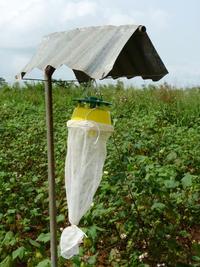Northeastern Benin - Angaradébou zone
Last update: 27 October 2017
The work done for Noelline Tsafack's thesis was primarily in Alibori département, near the village of Angaradébou (11°29’N - 3°20’E). The bollworm, Helicoverpa armigera, is a pest that is also seen during the dry season in the large market gardening zones a hundred or so kilometres further north, in the Malanville region on the banks of the River Niger, and on tomato during the rainy season, some thirty kilometres south in the Donwari region.
To analyse the influence of farming practices and landscape organization on the abundance and trophic origin of bollworms, in addition,to conventional entomological observations in the field and light traps, the study used various tools for typing the origins of the individuals captured, with spatial analysis approaches developed for landscape ecology, which are increasingly used in conservation biological control. Based on maps of the main plant stands recognized as potential hosts, their contribution to building successive generations of pests was analysed using isotope techniques (carbon to discriminate between C3 and C4 plants) and biochemical markers: cotton gossypol and glyco-alkaloids such as tomatine from Solanaceae.
Last update: 27 October 2017

